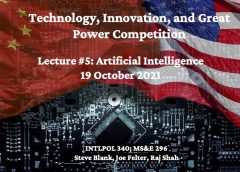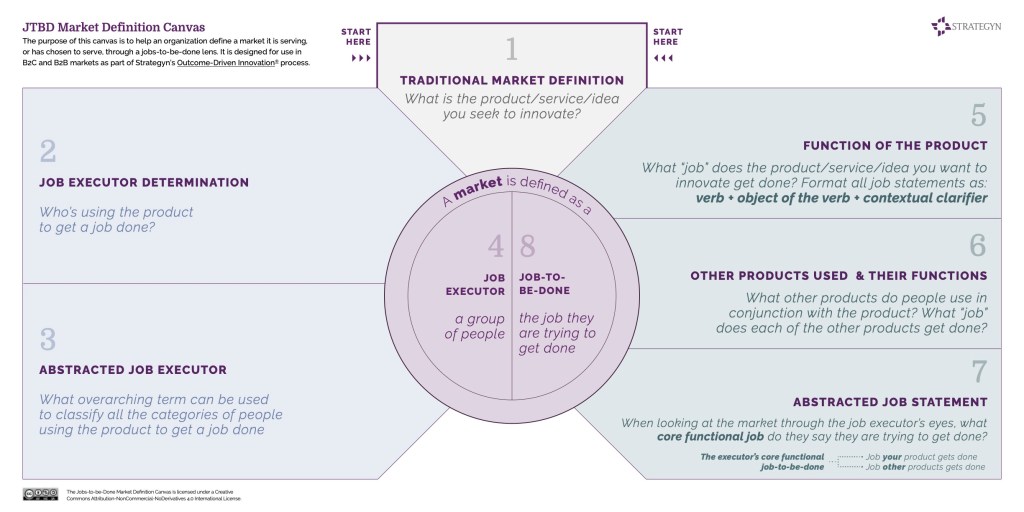
Steve Blank Technology, Innovation, and Great Power Competition – Class 5 – AI and Machine Learning
[ad_1]
This article first appeared in West Point’s Modern War Institute.![]()
We just completed the fifth week of our new national security class at Stanford – Technology, Innovation and Great Power Competition. Joe Felter, Raj Shah and I designed the class to cover how technology will shape all the elements of national power (America’s influence and footprint on the world stage).
In class 1, we learned that national power is the combination of a country’s diplomacy, information/intelligence, its military capabilities, economic strength, finance, intelligence, and law enforcement. This “whole of government approach” is known by the acronym DIME-FIL.
Class 2 focused on China, the U.S.’s primary great power competitor. China is using all elements of national power: diplomacy (soft power, alliances, coercion), information/ intelligence, its military might and economic strength (Belt and Road Initiative) as well as exploiting Western finance and technology. China’s goal is to challenge and overturn the U.S.-led liberal international order and replace it with a neo-totalitarian model.
The third class focused on Russia, which since 2014 has asserted itself as a competing great power. We learned how Russia pursues security and economic interests in parallel with its ideological aims. At times, these objectives complement each other. At other times they clash, as Russian policy is run by Vladimir Putin and his political institutions.
The fourth class shifted our focus to the impact commercial technologies have on DIME-FIL. The first technology we examined were semiconductors, the oil of the 21st century. The U.S. is dependent on TSMC, located in Taiwan, for its most advanced logic chips. This is problematic as China claims Taiwan is a province of China.
Today’s class: Artificial Intelligence / Machine Learning
Catch up with the class by reading our intro to the class, and summaries of Classes 1, 2, 3 and 4

Required Readings
Introduction to AI
The AI Arms Race: Fact or Fiction?
China’s AI Strategy
- Jeffrey Ding, “China’s Current Capabilities, Policies, and Industrial Ecosystem in AI” Testimony before the U.S.-China Economic and Security Review Commission Hearing on Technology, Trade, and Military-Civil Fusion: China’s Pursuit of Artificial Intelligence, New Materials, and New EnergyJune 7, 2019.
- Helen Toner, “Technology, Trade, and Military-Civil Fusion: China’s Pursuit of Artificial Intelligence, New Materials, and New Energy” Testimony before the U.S.-China Economic and Security Review CommissionJune 7, 2019.
- Ryan Fedasiuk, Jennifer Melot, Ben Murphy, “Harnessed Lightning, How the Chinese Military is Adopting Artificial Intelligence Center for Security and Emerging Technology (CSET)
Russian AI Strategy
US AI Strategy
Obama Administration
Trump Administration
Biden Administration
Other AI and National Security Resources
Reading Assignment Questions:
Pick one of the below questions and answer in approximately 100 words, based on the required readings. Please note that this assignment will be graded and count towards course participation.
- How would you characterize the geopolitical AI Arms Race? Is an “arms race” the right lens through which to understand this phenomenon, or is there another way to better understand great power competition in the AI domain?
- Can the U.S. learn any lessons from China’s AI strategy?
Class 5 – Guest Speakers
Our speakers for our fifth class were Mike Brown, Nand Mulchandani and Jacqueline Tame.
Mike Brown is the director of the Defense Innovation Unit (DIU) – a Department of Defense organization that contracts with commercial companies to solve national security problems. Previously Mike was the CEO of Symantec and Quantum.
Nand Mulchandani is the Chief Technology Officer of the Joint Artificial Intelligence Center (JAIC). The JAIC is the focal point of the Department of Defense AI strategy.
Jacqueline Tame was the former Acting Deputy Director of the JAIC and the architect of the JAIC “Gamechanger,” an AI-driven Policy Analysis Tool.
Mike Brown led off the session with an overview of the Defense Innovation Unit (DIU).
If you can’t see Mike Brown’s Defense Innovation Unit presentation click here.
Key takeaways from Mike’s talk were that 1) 50 years ago defense-related R&D made up 36% of global R&D. Today, defense-related R&D is 4%. Key technologies needed by defense today are made by commercial companies (5G, AI, biotech, quantum, access to space, batteries, etc.) 2) The top tech companies (Facebook, Alphabet, Microsoft, Amazon, and Apple) outspend U.S. prime contractors 11 to 1 in R&D ($70.5B versus $6.2B.)

DIU’s role is to find and then funnel commercial technology into the DoD by prototyping, transitioning, and scaling solutions. They have (by DoD standards) an extremely fast pipeline from problem curation, to evaluating and selecting companies, then prototyping projects and inserting them into DoD programs. AI/MLis one of the six core areas DIU focuses on (along with space, autonomy, advanced energy and materials, cyber and human systems.) DIU AI/ML has three lines of effort: machine Learning predictions, big data analysis, enhanced decision making.

Nand Mulchandani described the role and the initiatives of the JAIC. One in particular, Gamechanger, was conceived and run by Jacqueline Tame.
Gamechanger uses AI to tackle a problem only a government could create. The DoD and federal regulations have 10’s of thousands of policies, laws, regulations that tell decision-makers what they can or cannot do. These exist in different places on different networks and change almost daily. Now you could simply type a natural language query that asks, “Do I have the authority do x?” Or, “How can purchase this item quickly?” etc.
Lecture 5
If you can’t see the slides, click here
Our first discussion in class (Slide 7) was whether Nicholas Chaillan’s (the first Air Force Chief Software Officer) claim that we have already lost the AI battle to China was correct.
Slides 9-14 kicked off the discussion of the geopolitical implications of AI. Given both China and Russia have made a AI a national effort, how will AI impact all aspects of DIME (Diplomatic, Intelligence, Military, and Economic) and national power? What are the impacts of AI created deep fakes? AI automating image recognition of satellite data? AI creating optimal concepts of operations? AI-tuned cyber-attacks? AI cyber security? AI smart/predicative maintenance? etc. Where will we first see its impacts? What will our response be?
Class Discussion Questions: (Slide 15)
- How would you characterize the strengths and weaknesses of the U.S.’s AI Strategy?
- How would you advise the Biden Administration to pursue an AI Strategy?
Next week: Autonomy and Unmanned Systems
Lessons Learned
- AI and machine learning is a critical technology that will impact all aspects of DIME (Diplomatic, Intelligence, Military, and Economic) and national power
- Most of the advanced work in AI/ML is happening in commercial companies and universities not the DoD
- China and Russia have made AI and machine learning national priorities
- The Defense Innovation Unit (DIU) exists to find and then funnel commercial technology like AI/ML into the DoD
- The Joint Artificial Intelligence Center (JAIC) is the focal point of the Department of Defense AI strategy

Filed under: Technology Innovation and Great Power Competition |
[ad_2]
Source link


